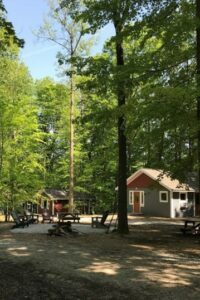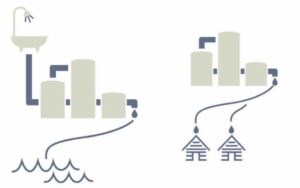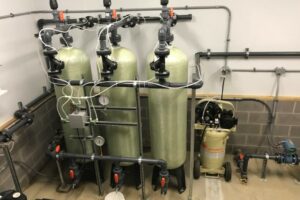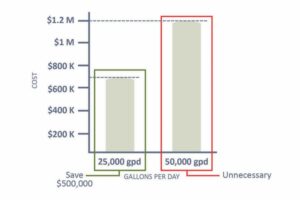
INDUSTRY TRENDS
Prevent “Waste”ful Spending – How to Afford Nice Amenities and the Necessary Infrastructure
January 11, 2023 | WRITTEN BY: Environmental Design Group
Written by: Dave McCallops, PE, Director of Water Resources
There are many reasons why visitors will select and then visit your campground. It might be the location, the beautiful landscape, amenities, programming, or a combination of these features, but it’s most likely not for the water or wastewater systems. However, when tough budgetary decisions are to be made, some campground owners may find themselves asking, “Are these improvements really necessary?”
Owners and operators of campgrounds are responsible for finding the balance between what will drive revenue and the infrastructure that makes it all work. But what if you didn’t have to choose? What if you could have the nice amenities that attract paying customers, the necessary infrastructure to make sure it works, and extra dollars too?
Most states overestimate standard water and sewer flow rates which has led to the significant overbuilding of water and wastewater systems at numerous campgrounds. Fortunately, there is a methodology to demonstrate the water usage for a campground that often allows the campground to push back on the standard flow rates and install smaller treatment plants than typically required thereby saving dollars, time, and developable land.
Time To Ante Up

The installation, operation, and maintenance of critically important drinking water and wastewater infrastructure can be very costly and are likely the most expensive but necessary services provided at a campground. But if you surveyed visitors on what they would like to view and experience, the infrastructure for drinking water and wastewater systems would probably rank dead last (unless you’re an engineer like me!). With regulations changing over the years, more and more existing campgrounds, along with new campgrounds, have had to install centralized water and wastewater-treatment systems to remain in compliance with regulatory agencies. So, what does that mean for your campground?
With a centralized water-treatment system or a wastewater-treatment system, the basic premise is similar. With the former, a treatment plant with water lines distributes the drinking water to serve the campsites and facilities in the campground. With the latter, a plant that is fed by a sanitary collection system that captures and directs the wastewater for proper treatment before discharging it underground or into a nearby creek, stream, river, or lake. The investment, as noted previously, is typically quite costly, which can—and often does—divert dollars away from planned investments for the campground.

In working with campgrounds that are facing the challenge of investing in the necessary infrastructure to meet changing regulations, we have found the biggest issue is regulatory standards that don’t reflect the historical water usage experienced by a typical owner of an RV or the campground serving their visitors. Throw in the fact that most campgrounds experience significant variations in flow over the course of the year (high in the summer to sometimes no flow in the winter) and building and operating your water and wastewater infrastructure can be time consuming and expensive.
Standards Vs. Reality
Most regulatory agencies have set standards in their regulations that define how much water a camper or individual campsite will typically use on a daily basis. These standards determine the volume of water that must be produced, treated, and delivered as drinking water, and then collected and treated as wastewater. However, the regulatory standards for water usage can double or even triple the actual amount needed for a campground in most cases.
So, how does that affect the budget? These overestimates used by regulatory agencies lead to water and wastewater treatment systems that are larger and more expensive than needed. Not only does this impact the upfront capital expenditure, but also the long-term operation and maintenance costs and the loss of developable land that otherwise might have be used to generate revenue.
Fortunately, there is a methodology to demonstrate the actual water usage versus the projected water usage for a campground that often allows installation of smaller treatment plants than are typically required. Working closely with the regulatory agency and having a proven track record of accuracy in these findings has saved some campground clients hundreds of thousands of dollars in construction costs along with long-term operation and maintenance costs.
Knowing how much water your campground uses and needs to treat can help avoid washing thousands of dollars down the drain that could have been used elsewhere.

Striking It Rich
We recently worked with a campground where the regulatory agency required the installation of a 50,000 gallon-per-day (gpd) wastewater treatment plant based on standardized regulatory water flow rates. However, after demonstrating to the regulatory agency that 25,000 gpd would more than suffice, a compromise was reached so that records would be kept by the campground, and if demand pushed the actual flow higher than 25,000 gpd, additional treatment at incremental 5,000 gpd segments would be added.
The bid for the treatment plant was approximately $750,000. While a 50,000 gpd treatment plant (what the standards would typically require) wouldn’t necessarily double the cost, $1.2-million is not an unreasonable estimate. That’s like finding an extra $500,000 to spend on visitor amenities instead of unnecessary infrastructure.
After keeping records over the past year or so, the actual average daily flow was recorded at approximately 7,500 gpd. Not only did the campground avoid constructing the costly 50,000 gpd treatment plant, the records indicate that the installed 25,000 gpd treatment plant is more than sufficient but the extra capacity can support additional demand to support a future campground expansion.

The Impact on Operations & Maintenance Dollars
A local campground installed a 60,000 gpd wastewater-treatment plant because that’s “what the numbers called for.” The plant sees an actual, average daily flow of approximately 7,500 gpd. The campground is using approximately 12.5 percent of the installed infrastructure daily. Even during major events or holiday weekends, when the campground is full with hundreds of additional visitors, the flows only reach approximately 35,000 gpd. The wastewater-treatment plant is nearly double what is needed during these events and eight times the size needed on a regular basis.
Along with the increased cost of construction, the oversized plant is difficult to properly operate with the limited flow rates and it annually diverts dollars that might otherwise be used to improve camper amenities for ongoing operations and maintenance.
Avoiding “Waste”ful Spending
Ask the right questions of your consultants to determine if they are merely following the standards or if they are thinking “outside the box” for ways to protect the environment and free up dollars to allow you as the owner to enhance the campground experience. Providing necessary infrastructure is part of the eternal “Is it nice or is it necessary?” debate. But what if you can have both—and some extra money to improve campers’ experiences? That would be a win-win for the campground and its visitors!
As “The Community Impact People,” Environmental Design Group (EDG) specializes in developing campgrounds that combine quality guest experiences with dynamic destinations. With more than 10 years of experience in the campground industry, we have provided planning, design, engineering and construction management services, along with marketing and communication strategies, for campground Owners and Investors across the country.
Our campground team is led by Stefanie Smith, AIA, LEED AP BD+C, Director of Camps & Campgrounds, Dave McCallops, P.E., Director of Water Resources, and Tammi Nagucki, CPSM, Principal of Marketing, Client Experience & EDG Creative.
For more information, please contact us at (330) 375-1390, [email protected], [email protected], or [email protected], or visit us at Booth #237 at the National Association of RV Parks & Campgrounds (ARVC) National Conference, November 7-10 in Orlando, Florida.
RELATED TAGS:
[xyz-ips snippet=”comment-form”]




